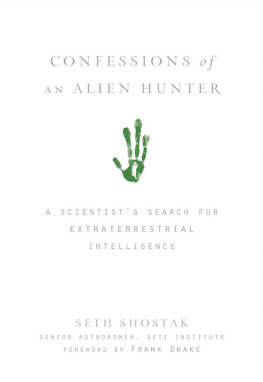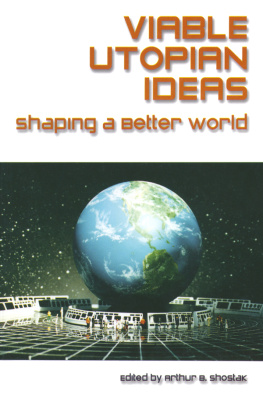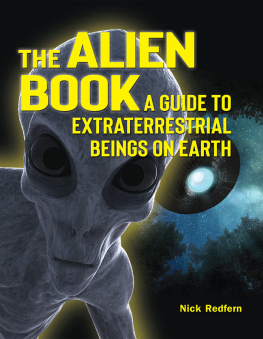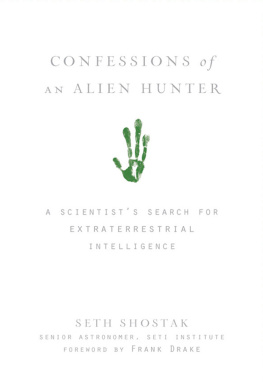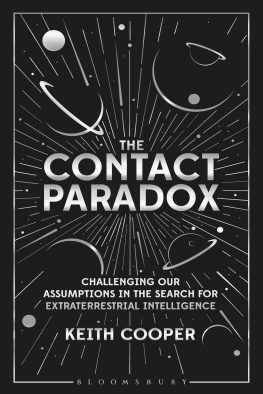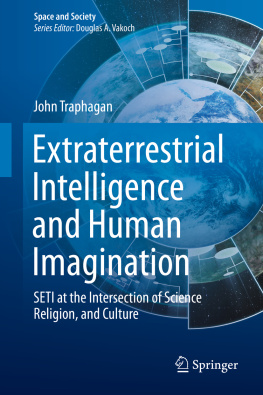CONFESSIONS of AN ALIEN HUNTER

A SCIENTISTS SEARCH FOR EXTRATERRESTRIAL INTELLIGENCE
SETH SHOSTAK

WASHINGTON, D.C.
Copyright 2009 Seth Shostak. All rights reserved. Reproduction of the whole or any parts of this book without written permission from the publisher is prohibited.
Library of Congress Cataloging-in-Publication Data
Shostak, G. Seth.
Confessions of an alien hunter: a scientists search for extraterrestrial intelligence/by Seth Shostak.
p. cm.
ISBN: 978-1-4262-0433-3
1. Life on other planets. I. Title.
QB54.S549 2008
576.839dc22
2008046731

Founded in 1888, the National Geographic Society is one of the largest nonprofit scientific and educational organizations in the world. It reaches more than 285 million people worldwide each month through its official journal, National Geographic , and its four other magazines; the National Geographic Channel; television documentaries; radio programs; films; books; videos and DVDs; maps; and interactive media. National Geographic has funded more than 8,000 scientific research projects and supports an education program combating geographic illiteracy.
For more information, please call 1-800-NGS LINE (647-5463) or write to the following address:
National Geographic Society
1145 17th Street N.W.
Washington, D.C. 20036-4688 U.S.A.
Visit us online at www.nationalgeographic.com
For rights or permissions inquiries, please contact National Geographic Books Subsidiary Rights: ngbookrights@ngs.org
FOREWORD
The trajectory of human history has frequently been changed by major events which redirected that path of history for good: for example, the rise of major religions, and the impact of major wars. In modern times, examples are the rise of Hitler and communism, and the development of antibiotics and nuclear energy. Sometimes these events required time to develop, as in the case of the industrial revolution, with the eventual consequences not recognized as the event transpired.
This book explores such a major world-changing event, which is in progress right now. Its eventual impact is largely unknown and thus largely unappreciated, although intuition tells us that the impact will be enormous and all to the good. It is the discovery of life in outer space, and of intelligent life in particular.
The idea of life in outer space is a very old one, going back to the Greek philosophers. The existence of other inhabitable worlds and extraterrestrial life has for hundreds of years been one of the few very prime questions in science. Not only would their discovery provide a bonanza of new scientific information, it would provide great insights concerning the significance and destiny of humanity: Where did we come from, are we unique, what is our place in the cosmos, and what might our future be?
The first major steps in learning of extraterrestrial life have occurred in little more than the last decade. Most important has been the detection of not just one, or a few, but hundreds of other planetary systems, some containing planets resembling the Earth, although not yet near twins to the Earththose are undetectable with current telescopes. History will judge this development to be one of the greatest milestones in the history of science. Yes, the best is yet to come. In the next few years, new instruments, such as the Kepler spacecraft, should tell us of the existence and abundance of Earthlike planets. This will usher in a wave of great discoveries about the abundance and detailed nature of Earthlike planets.
For more than 40 years, searches for signs of extraterrestrial technology, a surrogate for extraterrestrial intelligent creatures, have been taking place using the instruments of optical and radio astronomy to search for radio and light signals from other worlds. The rate of improvement in these systems is astonishing and will continue, perhaps even at an increased rate.
All of this progress has been the product of a limited group of ingenious and dedicated people, a characteristic typical of previous major forks in the path of history.
Seth Shostak has been fortunate to be an active participant in this group as it grew from a very small size to the large cohort of today. His description here of this history, and the remarkable people involved, comes directly from much firsthand personal experience, and can be counted on to be true.
Searching for extraterrestrial signals is one of the most challenging tasks ever taken on by mankind. There are more than a hundred billion stars which might, according to our limited present knowledge, be the source of such signals. The radio and optical spectrum allows the existence of perhaps billions of signal channels. We are faced with exploring a multitude of combinations of stars and channels for an elusive signal, whose actual form we can only guess. We are challenged to use logic to predict what another civilization, probably much older and more advanced than us, might adopt as a technology we might detect. Here we have no choice but to enter a realm of ill-informed speculation about the abilities and motivations of advanced civilizations. To reach an answer, we have to become futurists, reaching far beyond our usual comfortable world of telescope technology to arrive at possible scenarios for the distant future. This becomes an exercise of intellect reaching far beyond the usual bounds of science theory. It is the provocative theme of the latter part of this book. Is the future of sapient creatures to become symbionts with computers of unimaginable capability? To become, in a way, immortal, through our machines, and to be intelligent beyond our wildest dreams? If so, what will the signals be? What will the messages be? Will we even be able to recognize them, let along understand them? History is not encouragingour signals of today are very different from the signals of 40 years ago, which we then felt were perfect models of what might be radiated from other worlds of any state of advancement. We were wrong. If technology can change that much in 40 years, how much might it change in thousands or millions of years? Our powers of prediction so far have not been up to the task of answering this question.
So we must assume that the search will be long and demanding of time and resources, both material and human. We will be groping in the dark. Realism demands that we accept this scenario. But to Seth Shostak, and the others who join him in the search, it is all worth it because the end result will be discoveries leading us along a new and incredibly rich fork in the long road of terrestrial history.
Frank Drake
NEWS THAT WOULD CHANGE THE WORLD
It felt as if I was sweating on the inside. I was anxious and nervous, confronting a disturbing, if melodramatic, thought: This might be the most important day in the history of Homo sapiens.
The clock was easing past 3 a.m. on June 24, 1997, and we hadnt left the institute. On most nights, this room would be forlorn, just another bit of office space in the Silicon Valley, passively waiting for morning like a garaged car. But tonight the ceiling fluorescents hummed and flickered, while a half dozen co-workers sat in a line like Easter Island maoi, gazing at computer monitors. All that could be seen on the screens were a few lines of text and a graphic display. But they had our full attention.

